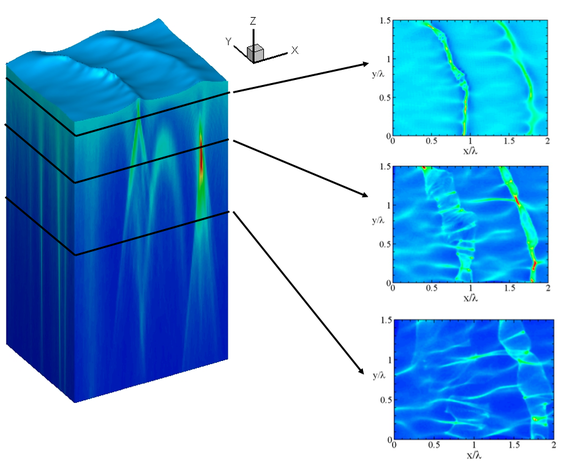We have expanded our research beyond conventional fluid mechanics to areas such as the propagation of electromagnetic (EM) and electro-optical (EO) signals in the atmospheric and oceanic environments, which are critical to many communication and operational applications.
In the atmospheric environment, EM and EO propagation are affected by the refractive index, which depends on the air temperature and moisture that are governed by atmospheric turbulence transport equations. In our studies, we have used our CFD tool of large-eddy simulation (LES) to perform high-fidelity simulations of diurnal cycle of atmospheric boundary layer (ABL). From the LES, detailed descriptions of the wind, temperature, and humidity fields are obtained, based on which the refractive index is quantified. We have found that the spatial distribution of refractive index is significantly influenced by the structures of different scales during the ABL cycle, which provides a physical basis for the development of improved EM and EO models.
For ocean optics, we have developed a Monte Carlo simulation tool for the radiative transfer equation. As light enters water from air, it is modified in propagation direction as well as in intensity at the interface, which is deformable and largely affected by surface waves and turbulence-induced surface roughness, subject to the Snell’s law and Fresnel transmission. The propagation of radiance in water is then captured by the simulation of photon transport subject to absorption and multiple scattering, which are affected by turbulence. Based on the statistics of photons and the associated Stokes vector, quantification of light field properties such as intensity, radiance, and polarization has been obtained from our study. Our major findings include the effect of ocean turbulence on the downwelling irradiance and the effect of surface waves on light polarization.
Selected Publications:
- Franklin, K., Wang, Q., Jiang, Q. & Shen, L. (2022), “Understanding evaporation ducts on turbulent eddy scales,” Journal of Geophysical Research - Atmospheres, accepted.
- Hao, X. & Shen, L. (2022), “A novel machine learning method for accelerated modeling of the downwelling irradiance field in the upper ocean,” Geophysical Research Letters, Vol. 49, e2022GL097769.
- Pan, M., Dong, Y., Zhou, Q. & Shen, L. (2022), “Flow modulation and heat transport of radiatively heated particles settling in Rayleigh-Bénard convection,” Computers and Fluids, Vol. 241, 105454.
- Wang, Q., Wauer, B.J., Yamaguchi, R.T., Alvarenga, O., Shen, L. & Crabbs, R. (2019), “Understanding optical turbulence using coordinated atmospheric measurements and large eddy simulation (LES) modeling,” Imaging and Applied Optics 2019 and Optical Society of America Technical Digest, paper PM3C.1.
- Wang, Q. et al. (2018), “CASPER: a multidisciplinary program on the coupled air-sea processes and electromagnetic wave (EM) ducting research,” Bulletin of the American Meteorological Society, Vol. 99(7), pp.1449-1471.
- Dickey, T. et al. (2012), “Introduction to special section on recent advances in the study of optical variability in the near-surface and upper ocean,” Journal of Geophysical Research – Oceans, Vol. 117, C00H20.
- Xu, Z., Guo, X., Shen, L. & Yue, D.K.P. (2012), “Radiative transfer in ocean turbulence and its effect on underwater light field,” Journal of Geophysical Research — Oceans, Vol. 117, C00H18.
- Xu, Z., Yue, D.K.P., Shen, L. & Voss, K. (2011), “Patterns and statistics of in-water polarization under conditions of linear and nonlinear ocean surface waves,” Journal of Geophysical Research - Oceans, Vol. 116, C00H12,

